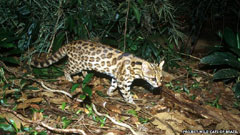 "Nosso estudo ressalta a necessidade urgente de atenção para a espécie que vive no nordeste, pois suas características biológicas são muito pouco conhecidas", afirma o professor da Faculdade de Biociências da PUCRS Eduardo Eizirik, observando que se sabe mais sobre a espécie do sul.
"Nosso estudo ressalta a necessidade urgente de atenção para a espécie que vive no nordeste, pois suas características biológicas são muito pouco conhecidas", afirma o professor da Faculdade de Biociências da PUCRS Eduardo Eizirik, observando que se sabe mais sobre a espécie do sul.O estudo, liderado por Eizirik e realizado em parceria com pesquisadores da Universidade Federal do Rio Grande do Sul (UFRGS) e de outras instituições brasileiras, revelou também um conjunto complexo de relações entre os felinos e outras duas espécies de gatos neotropicais. A história evolutiva aponta uma antiga hibridização entre o gato-dos-pampas (Leopardus colocolo) e a espécie de gato-do-mato-pequeno do nordeste brasileiro (Leopardus tigrinus). A espécie do sul, agora conhecida como Leopardus guttulus, apresentam uma zona híbrida com o gato-do-mato-grande (Leopardus geoffroy) na região central do Rio Grande do Sul, mostrando que a hibridação é um importante fenômeno que pode ocorrer entre animais de espécies diferentes.
Os responsáveis pela pesquisa acreditam que as espécies de gato-do-mato-pequeno encontradas no Brasil podem ter se adaptado para diferentes habitats. A do nordeste (L. tigrinus) vive principalmente no cerrado e na caatinga, enquanto a do sul (L. guttulus) está no ambiente mais úmido e denso da mata atlântica.
O professor Eizirik lembra que as quatro espécies de gato-selvagem estão ameaçadas. "Precisamos entender o máximo possível sobre sua genética, ecologia e evolução para sermos capazes de planejar estratégias adequadas de conservação".
Cryptic New Species of Wild Cat Identified in Brazil
By Cell Press
Researchers reporting in the Cell Press journal Current Biology on November 27th have found a cryptic new species of wild cat living in the northeastern savannahs and dry forests of Brazil. The discovery is a reminder of just how little scientists still know about the natural world, even when it comes to such charismatic creatures. The findings also have important conservation implications for the cats, the researchers say.
Scientists had thought there was a single species of house cat-sized Brazilian tigrina. However, the molecular data now shows that tigrina populations in northeastern versus southern Brazil are completely separate, with no evidence of interbreeding between them. As such, they are best described as two distinct species.
"Our study highlights the need for urgent attention focused on the Brazilian northeastern tigrinas, which are virtually unknown with respect to most aspects of their biology", said Eduardo Eizirik of Pontifícia Universidade Católica do Rio Grande do Sul in Brazil, noting that much more is known about the cats living in the southern part of the country.
The new study by Eizirik, Tatiane Trigo of Universidade Federal do Rio Grande do Sul and their colleagues further revealed a complicated set of relationships between the tigrinas and two other species of Neotropical cats. That evolutionary history includes ancient hybridization and movement of genes between the pampas cat and the north-eastern tigrinas (Leopardus tigrinus). In contrast, southern tigrinas (newly recognized as named L. guttulus) continue to hybridize with Geoffroy´s cats, leading to extreme levels of interbreeding between the species along their contact zone. Those patterns add to evidence that hybridization can and does occur between distinct animal species, as has been more widely recognized in plants.
As for the two tigrina species, the researchers suggest they may be suited to different habitats, with the north-eastern cats living primarily in savannahs as well as dry shrublands and forests and the southern species living in wetter and more dense Atlantic forests.
"Such distinct habitat associations provide a hint to potentially adaptive differences between these newly recognized species, and may have been involved in their initial evolutionary divergence", Trigo said. Moreover, Eizirik pointed out that "all four species are threatened, and we need to understand as much as possible regarding their genetics, ecology and evolution to be able to design adequate conservation strategies on their behalf".



